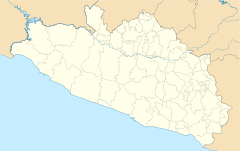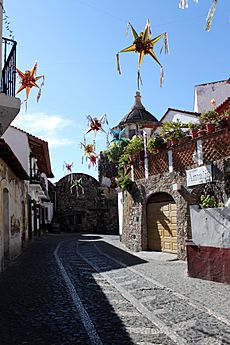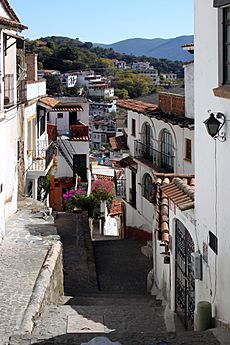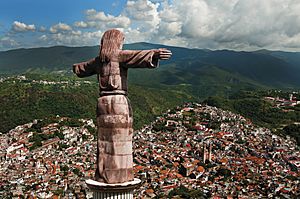Taxco facts for kids
Quick facts for kids
Taxco, Guerrero
|
||
|---|---|---|
| Taxco de Alarcón | ||
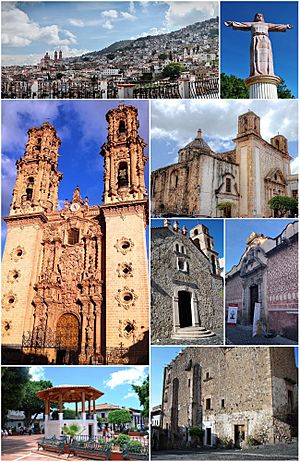
Top, from left to right: Overview of Taxco, The Monumental Christ of Taxco, Santa Prisca Temple (Templo de Santa Prisca), Church of the former monastery of San Bernardino de Siena, La Santisima Church, Museum of Viceregal Art, The House Borda and Plaza de Armas kiosk.
|
||
|
||
| Country | Mexico | |
| State | Guerrero | |
| Founded | 1529 | |
| Municipal Status | 1850 | |
| Area | ||
| • Municipality | 347 km2 (134 sq mi) | |
| Elevation
(of seat)
|
1,778 m (5,833 ft) | |
| Population
(2005) Municipality
|
||
| • Municipality | 98,854 | |
| • Seat | 39,587 | |
| Demonym(s) | Taxqueño (a) | |
| Time zone | UTC-6 (Central (US Central)) | |
| • Summer (DST) | UTC-5 (Central) | |
| Postal code (of seat) |
40200
|
|
| Area code(s) | 762 | |
Taxco de Alarcón (often called just Taxco) is a small city in the Mexican state of Guerrero. It is the main town of the Taxco de Alarcón Municipality. Taxco is located in the north-central part of the state. It is about 36 kilometers (22 miles) from Iguala and 170 kilometers (106 miles) southwest of Mexico City.
Taxco is famous for its silver. For a long time, people mined silver and other metals here. They also crafted beautiful silver jewelry and other items. Today, mining is not the main business. Instead, Taxco's reputation for amazing silverwork, along with its charming homes and beautiful scenery, has made tourism its most important activity.
Contents
History of Taxco
The name Taxco likely comes from the Nahuatl word Tlachco. This means "place of the ballgame." Another idea is that it comes from tatzco, meaning "where the father of the water is." This refers to a tall waterfall near the town. The "De Alarcón" part honors Juan Ruiz de Alarcón, a famous writer born in Taxco.
Like many towns in central Mexico, Taxco's symbol is an Aztec glyph. This symbol looks like a Mesoamerican ballcourt with rings, players, and skulls. This comes from the most likely origin of the name Taxco.
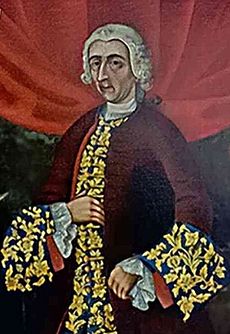
Before the Spanish arrived, the original village called "Taxco" was not where the modern city is now. That old village, now called Taxco El Viejo (Old Taxco), was about ten kilometers south. It was very important because it was where the Aztec governor collected taxes from seven nearby areas. The modern Spanish town of Taxco was started by Hernán Cortés in an area known as Tetelcingo. He chose this spot because there was a lot of silver here.
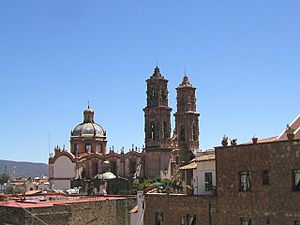
People started mining in this area even before the Spanish came. Native people dug up stones for decorations and ceremonies. The Spanish found large amounts of silver here around 1532. This led to a big increase in commercial silver mining.
In the mid-1700s, a man named José de la Borda came to Taxco. He started more modern mining operations in mines like Pedregal and San Ignacio. For most of the time Mexico was a Spanish colony, the area around Taxco was not very populated. Because of this, it was managed by Mexico City.
When the state of Guerrero was created in 1850, Taxco became the main town for its municipality. Since it was the only large town nearby, it was captured many times during different conflicts. It was taken during the Mexican War of Independence in 1815. Later, during the Reform Wars, Porfirio Diaz captured it in 1865. During the Mexican Revolution, it was taken by different groups in 1911 and 1916.
Silversmithing became popular again in Taxco thanks to an American named William Spratling. He moved to Taxco in the 1920s. He set up workshops where people designed and made silver items. These items were mostly sent to the United States. Because of its fame for silverwork, tourism became a very important part of Taxco's economy.
Geography and Climate
Taxco is located in the north-central part of the state of Guerrero. It is about 36 kilometers (22 miles) from Iguala and 170 kilometers (106 miles) southwest of Mexico City.
Taxco's Weather
The weather in Taxco is mild all year round. The average high temperature is about 27°C (81°F). The average low temperature is around 17°C (63°F). The dry season is from November to April. Most of the rain falls from June to September.
People and Development
In 2010, Taxco's population was 52,217 people. About 48% were men and 52% were women. Taxco's population grew quickly from 1950 (10,023 people) to 2000 (50,488 people).
Taxco has good development compared to other towns in Mexico. In 2010, about 38% of adults aged 15 and over did not finish basic education. About 6% of adults aged 15 and over could not read or write. Most homes (about 87%) had refrigerators, and 51% had washing machines. Only a small number of homes (about 8%) did not have running water.
| Population of Taxco, 1900-2010 |
|
EasyTimeline 1.90
|
| Source: Instituto Nacional de Estadística y Geografía. |
Economy and Getting Around
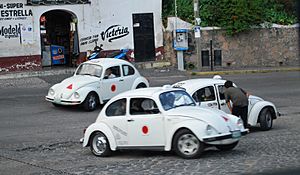
The main parts of Taxco's economy are silverwork and tourism. Mining is no longer a big job in the city. The last major mining company stopped most of its work in 2007. This was because the silver was running out and there were problems with workers.
Most businesses related to silver involve making and selling silver jewelry, silverware, and other items. Silver is sold both locally and to other countries. The streets of Taxco are full of silver shops.
Taxco has been named one of Mexico's "Pueblos Mágicos" (Magical Towns). This is because of its high-quality silverwork, its old colonial buildings, and the beautiful scenery around it.
Taxco is located along Mexican Federal Highway 95 and the toll road Mexican Federal Highway 95D. Taxco has two bus stations for long-distance travel. There is no airport in Taxco. To get around within Taxco, people usually use taxis or "Kombis." Kombis are converted Volkswagen vans that work like small buses.
Famous Silver Designers
Taxco was home to many important silver designers, especially in the early and mid-1900s. One of the most famous people who helped make Taxco silver popular was William Spratling. He was an American artist and architect.
Spratling discovered Taxco in 1929. He was very impressed by the local silversmiths' skills and traditions. Before Spratling arrived, Taxco was mainly a silver mining town. It was not known for designing silver. He worked with master silversmiths like Artemio Navarrete to set up his first workshop in Taxco.
Today, some modern designers still use the original techniques that Spratling and his students made popular. They create new silver pieces using silver from Taxco. More than 3,000 silversmiths live in Taxco today. This shows how much Spratling helped make Taxco known as the "Silver Capital of the World."
Cityscape and Historic Buildings
The city of Taxco is built on very hilly land. Its streets are steep and winding. They are also narrow and often do not have sidewalks. This makes them charming but can be tricky to walk on. Most streets are paved with dark stones. They have white stone lines, pictures, and even murals. Some of the pictures on the streets are from the Zodiac. These used to show where certain businesses were located. For example, the sign of Taurus near the Santa Prisca Church used to mark the butcher shops. Buildings in Taxco usually have Spanish-style red-tile roofs.
The town's main square is called Plaza Borda, named after José de la Borda. People often call it the Zócalo. On the north side of this square is the Casa Borda (Borda House). This is the most important non-religious building in the city. The front of the house facing the Zócalo has two floors. But the back, facing Plaza de Bernal, has five floors. This is because the house was built on uneven ground. A large part of the house is now the Casa de Cultura (Cultural Center). Here, people can take classes in languages, art, and sports like judo. Silver shops, restaurants, and bars surround the rest of the main square.
The Parish of Santa Prisca y San Sebastián, usually called the Santa Prisca Church, is on the east side of Taxco's main square. It is one of the few Baroque buildings in Guerrero state. José de la Borda, who became very rich from the silver mines, built it between 1751 and 1758. Even with his wealth, the church's fancy design almost made him go broke. It is built with pink stone and has two towers. The lower parts of the towers are plain, but the upper bell parts are highly decorated. The cupola (dome) is covered in colorful tiles. Inside, there are many tall altarpieces covered in gold.
Near the main square are two museums. The William Spratling Museum has silver and old artifacts from Spratling's own collection. The Museum of Viceregal Art is in the "Humboldt House." It is named after the German writer Alexander Von Humboldt, who stayed there in 1803. This house was fixed up in 1991 to become the Museum of Viceregal Art. It shows art and items from the colonial period, some of which belonged to José de la Borda.
Two other important churches are the Church of the former monastery of San Bernardino de Siena and the Church of Veracruz. The Church of the former monastery of San Bernardino de Siena is the oldest in the area. It was built in the late 1500s and fixed after a fire in the 1800s. The garden of this old monastery is now part of the Posada San Javier Hotel. The Church of Veracruz has a special image of Christ nicknamed "The General." This church is on the Plazuela de la Veracruz. This plaza is one of three places that have monuments to the writer Juan Ruiz de Alarcón. He was born in a house nearby.
On the north side of town is a large old silver processing plant called the Ex Hacienda del Chorrillo. Knights of Hernán Cortés built this hacienda. It is one of the oldest in the region. Part of its aqueduct, built in 1534, is still standing.
Culture and Traditions
Holy Week in Taxco involves special parades and ceremonies that are known around the world. Between Palm Sunday and Easter Sunday, there are ten big parades. Six happen in the evening, and four happen during the day. Most parades are about two and a half kilometers long and take about two hours. These traditions started as early as 1622 at the Church of the former monastery of San Bernardino de Siena. Now, these parades and ceremonies are centered around the Santa Prisca Church.
Other important events include the San Antonio Abad Festival in January. There are also the Jornadas Alarconianas (Alarconian Days) in May. The Jumil Festival is in October, and the National Silver Fair is in late November and early December.
Maize (corn) is a very common food in Taxco. Popular dishes include pozole (a type of soup) and tacos. Some dishes unique to Taxco are jumiles (a type of insect) prepared in tacos or Mole sauce. Other local foods include cecina (a cured meat), plum and bean tamales, and a drink called berta (a honey margarita). Criollo cheese is also a local specialty.
Basketball is the most popular sport in Taxco Municipality. In the city of Taxco, you can find courts for basketball, volleyball, and tennis, as well as soccer fields.
Images for kids
See also
 In Spanish: Taxco de Alarcón para niños
In Spanish: Taxco de Alarcón para niños



